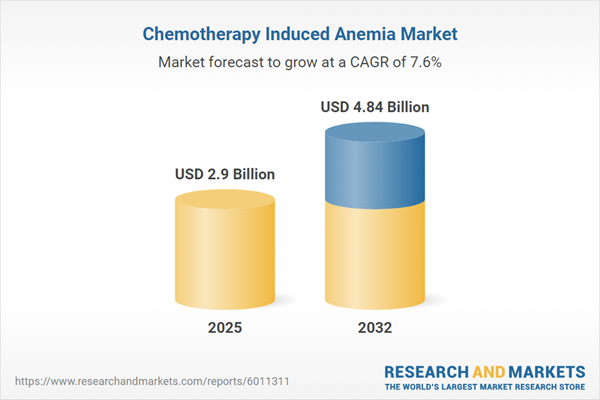Speak directly to the analyst to clarify any post sales queries you may have.
The chemotherapy induced anemia market is evolving rapidly as new therapies, advanced digital health solutions, and shifting global dynamics redefine patient management and commercial strategies in oncology supportive care.
Market Snapshot: Chemotherapy Induced Anemia Market Overview
The chemotherapy induced anemia market grew from USD 2.70 billion in 2024 to USD 2.90 billion in 2025 and is set to reach USD 4.84 billion by 2032, registering a CAGR of 7.57% over the forecast period.
Market expansion is fueled by rising cancer incidence, greater adoption of erythropoiesis stimulating agents, growth in biosimilar penetration, and advancements in supportive technologies. The sector is responding to both clinical complexities and increasing patient expectations, driving innovation in therapies and care delivery models worldwide.Scope & Segmentation
This comprehensive analysis offers actionable insights across market segments and geographies, supporting targeted planning for senior leadership. The report details:
- Therapy Type: Including blood transfusion, erythropoiesis stimulating agents, and iron therapy.
- Route Of Administration: Covering intravenous, oral, and subcutaneous methods.
- Product Type: Spanning biosimilars and originator molecules.
- Distribution Channel: Hospital pharmacy, online pharmacy (pharmacy websites and vendor platforms), and retail pharmacy (chain and independent pharmacies).
- End User: Clinics, home care, and hospitals.
- Treatment Setting: Inpatient and outpatient sites.
- Patient Demographics: Adult, geriatric, and pediatric patient groups.
- Region: Americas (North and Latin America), Europe, Middle East & Africa, and Asia-Pacific, with coverage across major countries and sub-regions.
- Leading Companies: Detailed analysis includes Amgen Inc., Johnson & Johnson, F. Hoffmann-La Roche Ltd, Teva Pharmaceutical Industries Limited, Sandoz International GmbH, Pfizer Inc., Biocon Limited, Dr. Reddy's Laboratories Limited, Intas Pharmaceuticals Limited, and Viatris Inc.
Key Takeaways for Senior Decision-Makers
- Growing complexity in the management of chemotherapy induced anemia requires coordinated strategies across diagnostics, treatment initiation, and long-term patient follow-up.
- Innovative therapies and biosimilars are broadening clinical and commercial options, placing pressure on traditional treatment algorithms and cost structures.
- Digital health platforms and telehealth integration are reshaping patient monitoring and adherence, enhancing supportive care in both hospital and home care settings.
- Personalized medicine is informing risk assessment and response monitoring, opening pathways for biomarker-driven segmentation and tailored therapeutic regimens.
- Supply chain sustainability and operational flexibility are vital in response to emerging reimbursement and sourcing challenges in key regions.
- Cross-border regulatory and trade policies, as well as diverse payer environments, necessitate region-specific commercial approaches to maximize patient access and market performance.
Tariff Impact and Supply Chain Considerations
Adjustments to United States tariff schedules in 2025 have reshaped the cost landscape for manufacturers and providers, influencing sourcing, production spending, and pricing negotiations. Elevated duties on pharmaceutical ingredients and delivery devices are prompting organizations to reevaluate global supply chains and expand domestic manufacturing strategies. These changes intersect with regulatory harmonization efforts, further impacting pricing frameworks and inventory management. Flexibility in sourcing, local partnerships, and proactive risk assessment are becoming standard for supply chain resilience.
Methodology & Data Sources
This report leverages a blended methodology, combining primary research such as expert interviews with oncologists, pharmacists, payers, and advocacy groups, with secondary research drawn from peer-reviewed publications, clinical trial databases, and regulatory filings. Analytical techniques include scenario modeling, cross-segmentation, and comparative benchmarking across regions. Rigorous data validation and expert panel review ensure that insights remain relevant and reflect the most up-to-date market shifts.
Why This Report Matters
- Aligns product development, pricing, and market entry strategies with evolving clinical guidelines and payer expectations.
- Supports operational decisions with data-driven insights into therapy trends, emerging administrative technologies, and regional variations.
- Helps stakeholders anticipate tariff impacts and regulatory changes, mitigating risk and sustaining growth in the supportive care segment.
Conclusion
Senior decision-makers gain a strategic roadmap for navigating the complexities of the chemotherapy induced anemia market. Leveraging the insights presented supports both operational excellence and future-ready patient care in a dynamic landscape.
Additional Product Information:
- Purchase of this report includes 1 year online access with quarterly updates.
- This report can be updated on request. Please contact our Customer Experience team using the Ask a Question widget on our website.
Table of Contents
3. Executive Summary
4. Market Overview
7. Cumulative Impact of Artificial Intelligence 2025
Companies Mentioned
The companies profiled in this Chemotherapy Induced Anemia market report include:- Amgen Inc.
- Johnson & Johnson
- F. Hoffmann-La Roche Ltd
- Teva Pharmaceutical Industries Limited
- Sandoz International GmbH
- Pfizer Inc.
- Biocon Limited
- Dr. Reddy’s Laboratories Limited
- Intas Pharmaceuticals Limited
- Viatris Inc.
Table Information
| Report Attribute | Details |
|---|---|
| No. of Pages | 197 |
| Published | November 2025 |
| Forecast Period | 2025 - 2032 |
| Estimated Market Value ( USD | $ 2.9 Billion |
| Forecasted Market Value ( USD | $ 4.84 Billion |
| Compound Annual Growth Rate | 7.5% |
| Regions Covered | Global |
| No. of Companies Mentioned | 11 |









